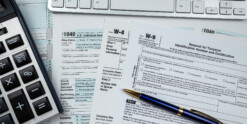The answer to that question depends on several factors. Of primary concern is, of course, the size of your nest egg. Is it robust or could it use some fattening? The desired size of your retirement savings account will, of course, depend largely on your personal post-career goals.
But have you ever wondered how your retirement savings stack up to other Americans’ accounts? Of course, you have! And that’s OK. It’s only natural to wonder about the Joneses, even if you’re not trying to keep up with them. And there is data on this very question, so you can see where you stand in relation to your friends, neighbors and colleagues.
According to the Economic Policy Institute, the average retirement savings balance is $124,831 for households between ages 50 and 55. For those between ages 56 and 61, the number is a bit higher, at $163,577.
So, how does your nest egg compare? Are you on track with the average, pacing ahead or running a bit behind? If you’re on target or better, then great! But if you have some catching up to do, fear not. It’s not as daunting as you may think.
For starters, at this stage in your career, you’re almost certainly bringing home a heftier salary than when you took your first job. So, while you still have bills and other obligations, you may be able to save more today than you were able to put away 10 or 20 years ago. A lot of folks are surprised at how steady saving each month can significantly grow their retirement savings.
Say you are able to put away $1,000 a month for the next 10 years. If we assume a conservative 6 percent rate of return, after a decade you will have amassed about $160,000. Not too shabby. If you are already around the national average for savings, this extra cushion will get you close to what I’ve found to be the magic number for happy retirees — $500,000 in retirement savings.
Let me explain this number and how I discovered it. In my book, “You Can Retire Sooner Than You Think,” I interviewed over 1,300 retirees to find out what made them happy (or unhappy). In the course of that research, I discovered that more money equals more happiness only to a point.
If you’re wringing your hands because you’ve read headlines that say you’ll need $2 million or more to retire, my advice is to stop and relax. Based on my research, a happy retirement is possible with just $500,000 in liquid net worth. And based on my professional experience, there is a “psychological comfort” that comes with hitting the half-million mark. After that, the happiness factor begins to plateau.
Digging deeper into the financial aspects of happy retirement, I found that the happiest retirees have between three or four different sources of retirement income. These money streams include things such as Social Security or pension benefits, income from investments, rental property income and part-time work.
Additionally, happy retirees are generally not extravagant spenders. Instead, they opt to “live in the middle.” For these folks, that means finding the Goldilocks spot for expenses like home values, vacations, restaurants, cars and general shopping.
For example, happier retirees are more likely to drive Toyotas, Hondas and Lexuses instead of BMW and Mercedes vehicles. In fact, BMW was the most popular luxury brand among unhappy retirees by a ratio of two to one. As for housing, I found that the happiest retirees live in homes valued at around $273,000, and are within five years of paying off their mortgage.
As for yearly expenses, the happy lot reported spending about $53,000 annually. If we assume a 20 percent effective tax rate, this means that a happy retiree needs an income of approximately $66,390 to net $53,112 each year.
And, as a final point, the happiest retirees reported spending roughly five hours a year planning for their retirement. This means that they know how much money they need and how much money they have saved for retirement. Using this knowledge, they can make adjustments when needed to find their sweet spot of financing their post-career years.
So, if you’re in your 50s, it may be useful to look at where are you in relation to other Americans when it comes to retirement savings. But, if you ask me, the most useful practice is in envisioning the retirement life you want and making that vision reality. And remember, you don’t need a million bucks to be happy. To the contrary, happiness seems to exist for folks operating with just half of that, living out their golden years in comfort, in the middle. For the happiest retirees, it’s the best place to be.
Read the original AJC article here.
DISCLOSURE
This information is provided to you as a resource for informational purposes only and should not be viewed as investment advice or recommendations. Investing involves risk, including the possible loss of principal. There is no guarantee offered that investment return, yield, or performance will be achieved. There will be periods of performance fluctuations, including periods of negative returns. Past performance is not indicative of future results when considering any investment vehicle. This information is being presented without consideration of the investment objectives, risk tolerance, or financial circumstances of any specific investor and might not be suitable for all investors. This information is not intended to, and should not, form a primary basis for any investment decision that you may make. Always consult your own legal, tax, or investment advisor before making any investment/tax/estate/financial planning considerations or decisions.













